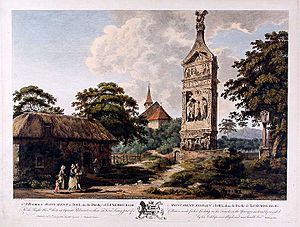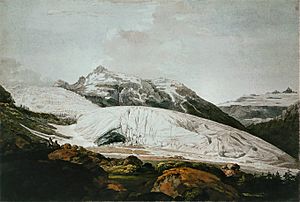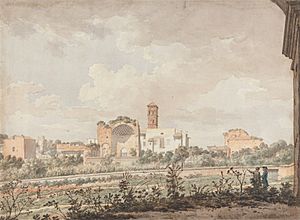William Pars facts for kids
William Pars was an English artist who lived from 1742 to 1782. He was known for painting portraits and landscapes using watercolors. He also worked as a draughtsman, which means he made detailed drawings, and an illustrator, creating pictures for books.
Contents
Early Life and Art Training
William Pars was born in London. His father was a metal engraver, someone who carves designs into metal. William began his art studies at a young age. He attended "Shipley's Drawing School" and the St. Martin's Lane Academy. He also learned at the Duke of Richmond's Gallery.
When he was just 17, in 1761, William Pars showed his artwork to the public. He displayed a portrait and some small paintings called miniatures at the Incorporated Society of Artists. By 1763, he became a member of the Free Society of Artists. The next year, in 1764, he won a medal from the Society of Arts for one of his historical paintings.
Travels and Famous Drawings
Journey to Greece
In June 1764, a group called the Dilettanti Society chose William Pars for an important job. They wanted him to travel to Greece as their official draughtsman. He went with two other important people, Richard Chandler and Nicholas Revett.
While in Greece, Pars made many detailed drawings of ancient buildings and ruins. These drawings were later used to illustrate a book series called Ionian Antiquities. This book helped people in England learn about the amazing old structures in Greece.
Exploring Europe
William Pars returned to England in December 1766. Soon after, he went on another trip to Europe with Henry Temple, 2nd Viscount Palmerston. During this journey, Pars created drawings of beautiful places in Switzerland, the Tyrol (a region in the Alps), and Rome.
In 1769, Pars showed seven of his Greek drawings at the very first exhibition of the Royal Academy. He became an associate member of the Royal Academy in 1770. The next year, he displayed eight more European views, mostly from Switzerland and the Tyrol, along with a portrait. He continued to show his artwork, mainly portraits, at the academy exhibitions until 1776.
Time in Rome
In the summer of 1775, William Pars received a scholarship from the Dilettanti Society. This allowed him to travel to Rome, Italy. Rome was a popular place for artists at that time. Other artists like John Warwick Smith, Francis Towne, John Robert Cozens, and Thomas Jones were also working there. Francis Towne, a friend of Pars, even learned some drawing tips from him.
William Pars stayed in Rome until the autumn of 1782. Sadly, he passed away there from a lung illness called pleurisy. His wife had also died in Rome a few years earlier, in June 1778.
Legacy and Family
Many of William Pars's drawings were later made into prints. Some of his Greek drawings were engraved by William Byrne for the Dilettanti Society. Five of his Swiss drawings, including one of the Mer de Glace (a famous glacier), were engraved by William Woollett. Other drawings were made into prints using a technique called aquatint by Paul Sandby.
William Pars had an older brother named Henry Pars (1734–1806). Henry was also a draughtsman and metal engraver. He even became the head of Shipley's Drawing School, where William had studied. William's sister, Anne, also showed artistic talent as a pastellist, meaning she worked with pastel crayons.
See also
- James Stuart (1713–1788) – Like Pars, he also recorded ancient buildings in Greece and traveled with Nicholas Revett.




